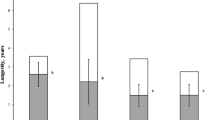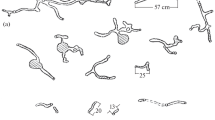Abstract
The features, population characteristics of reproduction, nutrition, and lifestyle of an extremely poorly studied narrow-range species of underground rodents—the false zokor (Myospalax aspalax)—have been described on the basis of original field materials. The data were obtained within the Russian part of the species range in Zabaikal’skii krai. The false zokor is characterized by a pronounced sexual dimorphism in body size (males are larger) and a predominance of females in the population. Mating takes place in April; at other times of the year, zokors lead a solitary lifestyle. The size of the brood is small: 3.7 embryos per breeding female. Their preferred food is bulbs and rhizomes of Allium, Thermopsis, Phragmites, and Leymus. In Eastern Transbaikalia, they are active in winter.
Similar content being viewed by others
References
Bannikov, A.G., Mlekopitayushchie Mongol’skoi narodnoi respubliki (Mammals of the Mongolian People’s Republic), Tr. Mongol. Eksped., Moscow, 1954, vol. 53.
Bobrinskii, N.A., Kuznetsov, B.A., and Kuzyakin, A.P., Opredelitel’ mlekopitayushchikh SSSR (Identification Key to Mammals of the Soviet Union), Moscow: Prosveshchenie, 1965.
Dmitriev, P.P., Mlekopitayushchie v stepnykh ekosistemakh Vnutrennei Azii (Mammals in Steppe Ecosystems of Inner Asia), Biologicheskie resursy i prirodnye usloviya Mongolii. Trudy Sovmestnoi Ros.-Mong. kompl. biol. Ekspeditsii (Biological Resources and Natural Conditions of Mongolia: Proc. Joint Soviet–Mongolian Integrated Biological Expedition), Moscow, 2006, vol. 48.
Gromov, I.M. and Erbaeva, M.A., Mlekopitayushchie fauny Rossii i sopredel’nykh territorii. Zaitseobraznye i gryzuny (Mammals in the Fauna of Russia and Neighboring Territories: Lagomorphs and Rodents), St. Petersburg, 1995.
Jingang Li, Jinming Li, and Ya Zhao, Preliminary analysis on population dynamics and effect factors of Gansu zokor (Myospalax cansus), Acta Theriol. Sinica, 1999, vol. 19, no. 2, pp. 158–159.
Junsen Wang, Jinsong Liu, Xiuzhi Yang, Deyi Zhao, Jizheng Cheng, et al., Principal component analysis of growth index of population for Manchurian zocor (Myospalax psilurus), Acta Theriol. Sinica, 1997, vol. 17, no. 1, pp. 75–77.
Karaseva, E.V. and Toshchigin, Yu.V., Gryzuny Rossii (Obraz zhizni, znachenie v narodnom khozyaistve, metody izucheniya i kontrol’ chislennosti) (Rodents of Russia: Mode of Life, Economic Significance, Methods of Study, and Population Control), Moscow: Inst. Evol. Morfol. Ekol. Zhivotnykh, Ross. Akad. Nauk, 1993.
Makhmutov, S.M., The Altai zokor in Eastern Kazakhstan: ecology and economic significance, Extended Abstract of Cand. Sci. (Biol.) Dissertation, Alma-Ata, 1973.
Makhmutov, S.M., The Altai (Siberian) zokor, Myospalax myospalax Laxmann, 1773, in Mlekopitayushchie Kazakhstana (Mammals of Kazakhstan), Alma-Ata: Nauka, 1978, vol. 1, part 3, pp. 424–448.
Makhmutov, S.M., Spivakova, L.V., and Yantsen, A.A., Reproduction of the Altai zokor in Eastern Kazakhstan, Trudy Inst. Zool. KazSSR, 1973, pp. 181–199.
Nekipelov, N.V., Data on the biology of zokor Myospalax dybowskii Tschersky, Byull. Mosk. O-va Ispyt. Prir., Otd. Biol., 1946, vol. 51, nos. 4–5, pp, 71–78.
Skalon, V.N., Observations on the mode of life of zokor Myospalax dybowskii in Mongolia, Uch. Zap. Mongol. Univ., 1946, vol. 1, no. 1, pp. 76–80.
Sokolov, V.E. and Orlov, V.N., Opredelitel’ mlekopitayushchikh Mongol’skoi Narodnoi Respubliki (Identification Key to Mammals of the Mongolian People’s Republic), Moscow: Nauka, 1980.
Tupikova, N.V., Analysis of reproduction and age composition of small mammal populations, in Metody izucheniya prirodnykh ochagov boleznei cheloveka (Methods of Studies on Natural Foci of Human Diseases), Moscow: Meditsina, 1964, pp. 154–194.
Wang, T.Z. and Li, X., Study on reproductive characteristics of Gansu zocor and Chinese zocor, Acta Theriol. Sinica, 1993, vol. 13, no. 2, pp. 153–155.
Zhang Yanming, The biology and ecology of plateau zokors (Eospalax fontanierii), in Subterranean Rodents: News from Underground, Berlin: Springer, pp. 237–249.
Author information
Authors and Affiliations
Corresponding author
Additional information
Original Russian Text © Yu.A. Bazhenov, 2016, published in Zoologicheskii Zhurnal, 2016, Vol. 95, No. 4, pp. 458–464.
Rights and permissions
About this article
Cite this article
Bazhenov, Y.A. Features of the Biology of the False Zokor (Myospalax aspalax, Rodentia, Spalacidae) from Eastern Transbaikalia. Biol Bull Russ Acad Sci 44, 807–812 (2017). https://doi.org/10.1134/S1062359017070020
Received:
Published:
Issue Date:
DOI: https://doi.org/10.1134/S1062359017070020




